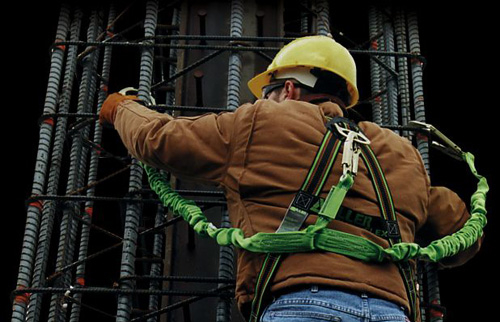Jan 25th 2024
Keeping Workers Safe at Heights – PPE and Fall Protection Training
Whatever industry you work in, keeping your workers safe is of paramount importance. Of course, you need to keep in compliance with Occupational Health and Safety Administration (OSHA) standards. Failing to comply and allowing workers to be injured can carry stiff financial penalties.
As you’re well aware, OSHA keeps a close watch on industry when it comes to the safety and well-being of employees. And OSHA believes that far too many preventable injuries, illnesses, and deaths occur in the workplace. Accidents and exposures that could have been easily prevented if proper measures and training had been implemented.
But penalties aside, we need to understand the impact that workplace illnesses and injuries have, not just on the employee, but on their families as well. Nobody wants to get the call that their spouse, loved one, parent or sibling has been injured, or even killed, due to a workplace accident. Along with the financial hardships incurred—which may or may not be overcome easily—the emotional damage done will stay with them forever.
OSHA’s Most Frequently Cited Workplace Standards Violations
The Occupational Health and Safety Administration recently published their top 10 most recently cited standards for Fiscal Year 2021. The list was also presented at the 2021 NSC Safety Congress & Expo by Patrick Kapust, deputy director of OSHA's Directorate of Enforcement Programs.
For the eleventh year in a row, fall protection (1926.501) remains at the top of the list, as presented on the official OSHA website. In Fiscal Year 2021, there were a reported 5,295 violations cited. The sixth most cited violation was fall protection training requirements, with over sixteen hundred citations issued.
Why does fall protection violations remain at the top for so long? Well, it’s interesting to note that fall protection training moved up in the list, being cited as the #8 violation in 2019. It might be safe to infer that a lack of proper fall protection training has led to fall protection violation’s continuing reign at the top of the citation heap.
By the way … ladders and scaffolding citations in construction came as the third and fifth most cited violations, respectively.
What Your Team Needs to Know About Working at Heights
Remember that number 6 on OSHA’s top 10 list addressed the lack of training for fall protection. (By the way, some websites say that Lockout/tagout is #6 and fall protection training violations is #7. This article is based on the official OSHA website information. Either way … it’s a problem to address.)
The fact is that you can’t just send people into situations that require fall protection knowledge without ensuring they know the score.
That means everything from when to use fall protection gear to knowing how to use it properly. Approved OSHA construction safety training needs to be an important part of on the job training, and even pre-job instruction. It’s not enough to know how to perform jobsite tasks. Crew members must know and understand how to work safely as well.
- How to select the correct fall protection PPE components for the job
- How to do a daily inspection on critical parts of a PFAS
- How to don and doff fall protection harnesses properly
- How to hook up correctly to anchorage points when working at heights
- Recognition and identification of fall hazards
- What to do in the event of a fall, either their own or that of a coworker
In the first point—how to select the correct fall protection PPE—it’s necessary to know that there are different styles of safety harnesses, each designed for a particular application. For example, D-ring placement is often determined by the application in which the harness is used. Back mounted D-rings are standard, and will be used to attach lanyards, both stationary and self-retracting, as well as attachment points for fall recovery operations.
If the construction worker will be routinely climbing fixed vertical ladders in which a vertical-ladder climbing system is installed, a front mounted attachment point will be necessary. D-rings attached to the sides are used for attaching positioning belts.
Even the choice of lanyard is often dependent on the jobsite application. The two basic types are fixed-length energy absorbing lanyards, and self-retracting lanyards called SRLs. SRLs give the most possible range of movement and come in a variety of lengths. Web-style SRLs are often used indoors, while cable-style SRLs are used in outdoor environments or in areas where more durability against abrasions or high-heat is required.
If using shock-absorbing lanyards, you must ensure the worker is anchored at least 17.5 to 18 feet above the next surface. These lanyards have coiled up webbing that is pulled from a pouch to slow down and absorb the shock of the fall at the end. Obviously, if a lanyard doesn’t fully deploy before the worker hits the ground, serious foot, leg and back injuries could be incurred.
Best Practices for Training Workers in Fall Protection and Other Safety Topics
Training your construction crew is vitally important. And it’s important that it be done correctly and to OSHA specifications. Yes, OSHA does have specific recommendations and requirements for any type of safety training.
29 CFR 1926, Subpart C, standard number 1926.21 addresses the general requirements and employer responsibilities for safety training. As for the responsibilities:
1926.21(b)(2) The employer shall instruct each employee in the recognition and avoidance of unsafe conditions and the regulations applicable to his work environment to control or eliminate any hazards or other exposure to illness or injury. Train workers about job hazards in a language that they can understand.
In most every standard regarding training in any safety topic, you’ll find that one common theme. The training must be understandable by the employee, regardless of language, educational level, or other personal circumstances.
Not only that, but the training must also be documented properly and records retained:
1926.503(b)(2) The latest training certification shall be maintained.
There are resources on the OSHA website you can use to form a qualified training program. Some companies do that. It can be time consuming to say the least.
Another option that many employers are turning to is hiring training companies who specifically specialize in compliant safety training. These companies are equipped and prepared to ensure all employees understand the ins and outs of the safety topics presented.
While many in-person training programs are held at the employers location, an increasing number of approved OSHA online courses are offered that can be accessed by individuals via computer, laptop, tablet or smartphone.
The employees are able to study at their own pace, take certification tests online, and those tests are stored in a database to satisfy OSHA’s documentation retention requirements. The cost of these programs is minimal compared to the potential costs associated with injuries, deaths, and OSHA penalties.
Safety doesn’t cost on the construction site … it pays off with huge dividends.


